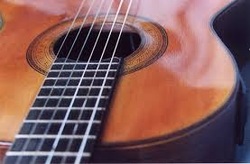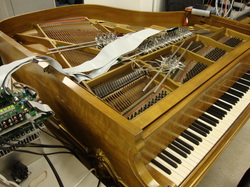Chordophones: What are they?

A big hint as to what instruments make up this group comes from the name itself, which has the root word "chord". Chordophones are instruments which have strings which are stretched tightly between two points. When these strings are struck or plucked, they vibrate and produce a sound.
So this means that any of our stringed instruments from class like our guitars, bass guitars, and violins all fall into this category. Can you think of any other instruments that have strings that we use in band??? Did you think of the piano?
So this means that any of our stringed instruments from class like our guitars, bass guitars, and violins all fall into this category. Can you think of any other instruments that have strings that we use in band??? Did you think of the piano?
The piano is a chordophone? It has strings?

This might be surprising to some, but a piano actually has many strings located behind its cover. In fact, inside every acoustic piano there is an individual string for each and every white and black key. When we press one of these keys down, it releases a little hammer that hits an assigned string, causing it to vibrate and produce a sound!
Factors that affect chordophones:
- Material: Just as with our idiophones and membranophones, the material that our instrument is made up of has a big impact on what sound it makes. Since we're dealing with stringed instruments, the type of strings used, and their thickness can change the timbre of the sound. Also, the type of wood or material that is used for the body of our violins, guitars, basses also can play a huge roll in the instruments sound quality.
- Size: The trend continues here that the bigger the instrument is, the lower the notes it makes will sound! This is why our violin's notes sound so much higher than the ones played on a bass, even though both instruments have 4 strings, and can be "tuned" the same way.
- Tuning: We learned above that all instruments in this family have strings that are stretched tightly between two points, creating tension. These instruments also all have ways to adjust the level of tension in these strings by twisting the little pegs located at the top. We can either twist the string tighter which makes the tuning higher, or loosen it, making the tuning lower.